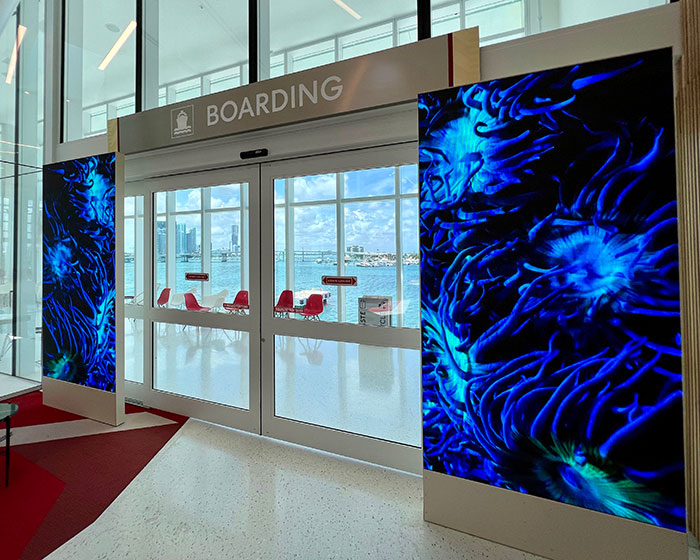Coral City Camera – 7 Month Coral Growth, Bleaching, & Erosion Timelapse (5.1.23-12.8.23)
Sunday, December 31st, 2023The summer of 2023 will go down as the hottest in recorded history (thus far). Sadly, hot ocean water means coral bleaching, and Florida’s corals suffered tremendously this year. Fortunately the Coral City Camera was in position to create the world’s most comprehensive in-situ coral bleaching timelapses ever documented by human technology. Many attempts have been made to record a coral bleaching event, but to our knowledge, this is the most complete and longest running coral time lapse made underwater in a coral reef environment. The time lapse begins on May 1st, 2023 and you can see that the staghorn corals start growing and branching quickly. However, by mid-July water temperatures have reached the critical bleaching threshold of 87 degrees Fahrenheit (30.5C) and quickly turn white. The transplanted staghorns and elkhorn corals not only bleached, but they subsequently died. You can see how after turning white, they turn gray-brown as they are colonized by turf algae in August and September, and then they erode almost as quickly as they grew, expedited by the abundant parrotfish that graze this algae from the corals’ limestone skeletons.
Bleaching occurs when the metabolism of the golden-brown symbiotic algae that live in the coral tissue known as zooxanthellae goes into thermal overdrive. The algae’s production of photosynthetically-produced oxygen exceeds the limit the coral can safely handle inside its tissues, resulting in expulsion of the zooxanthellae (and its brown color) from its host. Because zooxanthellae normally provide a coral with photosynthetically-produced sugars, it begins to starve without these symbionts. Fast-growing corals like the endangered staghorn (Acropora cervicornis) and elkhorn (Acropora palmata) lack the energy stores that fleshier corals like brain corals have, and die from bleaching stress much more easily.
By the end of August 2023, all of the staghorn and elkhorn corals experimentally-transplanted by the University of Miami’s Rescue a Reef program succumbed to the excess heat and bleaching. These were corals that are native to cooler, cleaner waters offshore Miami, so it didn’t come as a complete surprise that they could not survive the urban reef environment around the CCC. However, a single strain of staghorn and elkhorn coral that are native to the Port did not bleach and continued growing happily despite water temps exceeding 90 degrees Fahrenheit (+32C). Not taking any chances, we brought fragments of these urban strains of stag and elkhorn coral into climate-controlled conditions at NOAA’s Atlantic Oceanographic Marine Lab in July. Once water temperatures cooled enough, these fragments were safely returned to the CURES (Coral Urban Research Experimental Site) nursery frame that sits about 20’ from the CCC.
Many corals like the mustard hill coral (Porites asteroides) did not fully recover from bleaching until December 2023. Most of the brain corals had recovered from bleaching by November 2023.
Amazingly, a significant number of corals native to PortMiami did not bleach, suggesting that they have a combination of genes and microbiomes that have enabled them to adapt to the Anthropogenic conditions along Miami’s urban coastline. The native urban corals that did bleach managed to survive for several months without any zooxanthellae to provide them with energy, before recovering new zooxanthellae in autumn when cooler water returned. It is possible that the higher levels of nutrients and plankton in the water helped provide these corals with additional energy captured as food.
These urban corals and the bleaching timelapses highlight the scientific value of the Coral City Camera and its ability to document what was previously undocumented. After 4 years of near-continuous recording, and more than 205 species of fish cataloged, there is no underwater coral reef site anywhere in the world that has been as thoroughly recorded and archived.
While corals throughout Florida and the Keys suffered tremendously in the summer of 2023, the stressful event also demonstrated that not all corals shared the same fates. Even within the same species, some corals did not bleach, bleached and recovered, or bleached and died. Studying the resilient strains of urban corals at PortMiami may illuminate how they’ve been able to adapt to marginal conditions and excessive heat. With global fossil fuel emissions continuing to rise unsustainably, we can expect even hotter summers in the years to come. Will corals be able to adapt naturally fast enough? Will scientists be able to accelerate the evolution of these corals to withstand hotter water temperatures? We are in an existential race against time, but we believe (now more than ever) that Miami’s urban corals will play an important role in finding out what makes a resilient coral ‘super’. The newly launched Coral City Foundation aims to build a land-based coral lab in 2024 to unlock these secrets and amplify their numbers.




